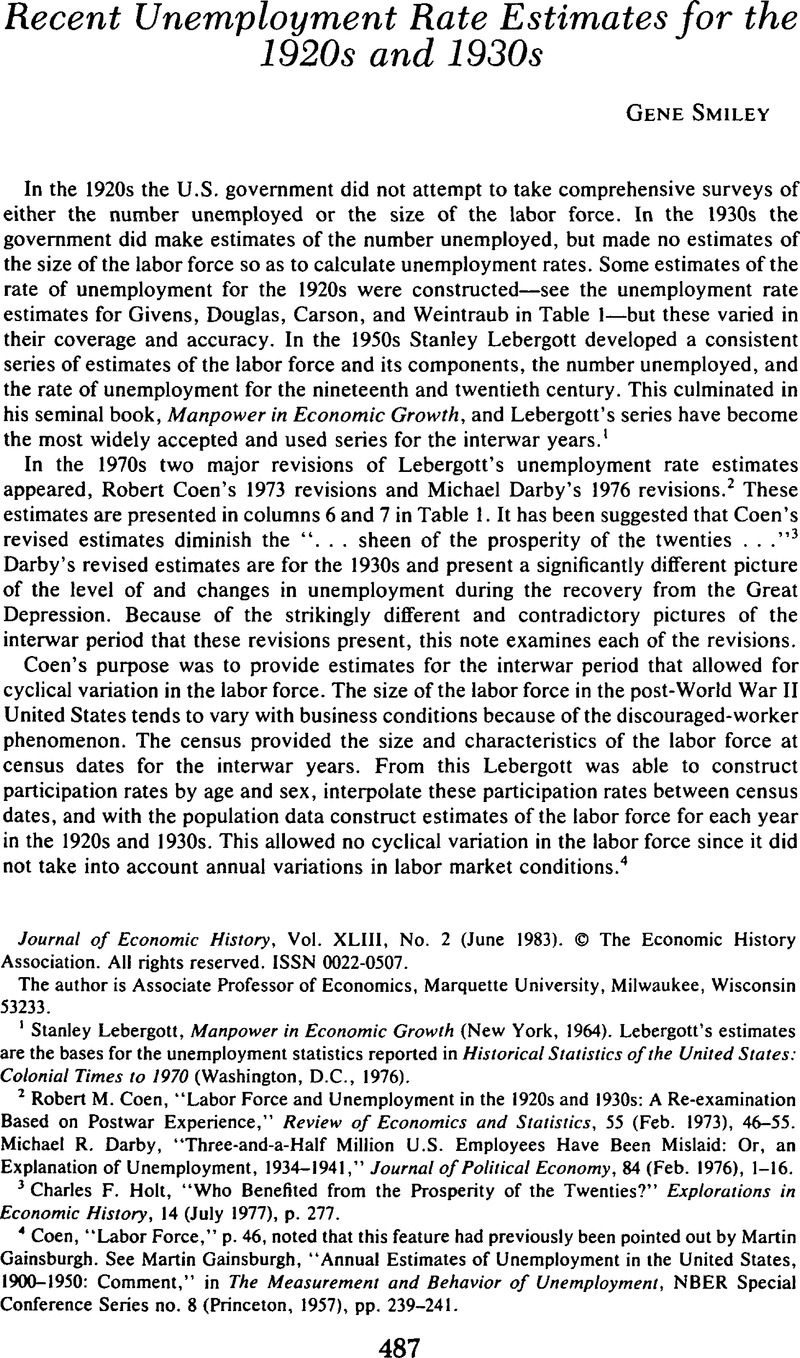Article contents
Recent Unemployment Rate Estimates for the 1920s and 1930s
Published online by Cambridge University Press: 03 March 2009
Abstract

- Type
- Notes and Discussion
- Information
- Copyright
- Copyright © The Economic History Association 1983
References
1 Stanley Lebergott, Manpower in Economic Growth (New York, 1964). Lebergott's estimates are the bases for the unemployment statistics reported in Historical Statistics of the United States: Colonial Times to 1970 (Washington, D.C., 1976).
2 Coen, Robert M., “Labor Force and Unemployment in the 1920s and 1930s: A Re-examination Based on Postwar Experience,” Review of Economics and Statistics, 55 (02 1973), 46–55.CrossRefGoogle ScholarDarby, Michael R., “Three-and-a-Half Million U.S. Employees Have Been Mislaid: Or, an Explanation of Unemployment, 1934–1941,” Journal of Political Economy, 84 (02 1976), 1–16.CrossRefGoogle Scholar
3 Holt, Charles F., “Who Benefited from the Prosperity of the Twenties?” Explorations in Economic History, 14 (07 1977), p. 277.CrossRefGoogle Scholar
4 Coen, , “Labor Force,” p. 46, noted that this feature had previously been pointed out by Martin Gainsburgh.Google Scholar See Gainsburgh, Martin, “Annual Estimates of Unemployment in the United States, 1900–1950: Comment,” in The Measurement and Behavior of Unemployment, NBER Special Conference Series no. 8 (Princeton, 1957), pp. 239–241.Google Scholar
5 Coen, , “Labor Force,” p. 51.Google Scholar
6 Coen, , “Labor Force,” pp. 51–52.Google Scholar
7 Coen, , “Labor Force,” pp. 53–54.Google Scholar
8 Darby, , “Three-and-a-Half Million,” pp. 8 and 10.Google Scholar
9 This must especially have been the case during the 1920s and 1930s. Consider the quite common observation that in the 1930s on the farm there was no unemployment but dramatic declines in real and nominal incomes, while in nonform occupations, there was massive unemployment but relatively little real income decline for those who were able to keep their full-time jobs. Because of this the share of the employed labor force working on farms rose sharply during the Great Depression.Google Scholar
10 Coen, , “Labor Force,” p. 51. Coen also suggests a vague criterion of the“… reasonableness of the behavior of our labor force estimates in the remaining intercensoral years, considering other information available” (p. 51). Since the behavior under consideration is cyclical variation in the labor force resulting from the discouraged-worker effect, and for the interwar years there is no information available on this, it is not clear what constitutes “reasonable behavior.”Google Scholar
11 His model originally underpredicted by 2.709 million (or 5.58 percent) in 1930 and 3.290 million (or 5.91 percent) in 1940. After Coen's “seemingly arbitrary adjustment”of the constant term, his model estimated a 0.633 percent larger labor force than actual labor force in 1922, a 0.205 percent larger than actual labor force in 1930, and a 0.205 percent smaller than actual labor force in 1940. The percentages are calculated from Coen, , “Labor Force,” Table 2, p. 51. Because of the cyclical variation his model introduces, these comparisons cannot be made for other years.Google Scholar
12 Lucas, Robert E. Jr, and Rapping, Leonard A., “Unemployment in the Great Depression: Is There a Full Explanation?” Journal of Political Economy, 80 (01/02 1972), 186–191.CrossRefGoogle Scholar
13 Darby, , “Three-and-a-Half Million,” p. 9.Google Scholar
14 Darby, , “Three-and-a-Half Million,” p. 1.Google Scholar
15 Gordon, Robert J., “Recent Developments in the Theory of Inflation and Unemployment,” Journal of Monetary Economics, 2 (04 1976), 185–219;CrossRefGoogle ScholarKesselman, J. R. and Savin, N. E., “Three-and-a-Half Million Workers Never Were Lost,” Economic Inquiry, 16 (04 1978), 205–225;CrossRefGoogle ScholarGordon, Robert J. and James A. Wilcox, “Monetanst Interpretations of the Great Depression: An Evaluation and Critique,” chapter 2, pp. 49–107Google Scholar in Brunner, Karl, ed., The Great Depresssion Revisited (Boston, 1981).CrossRefGoogle Scholar
- 11
- Cited by




